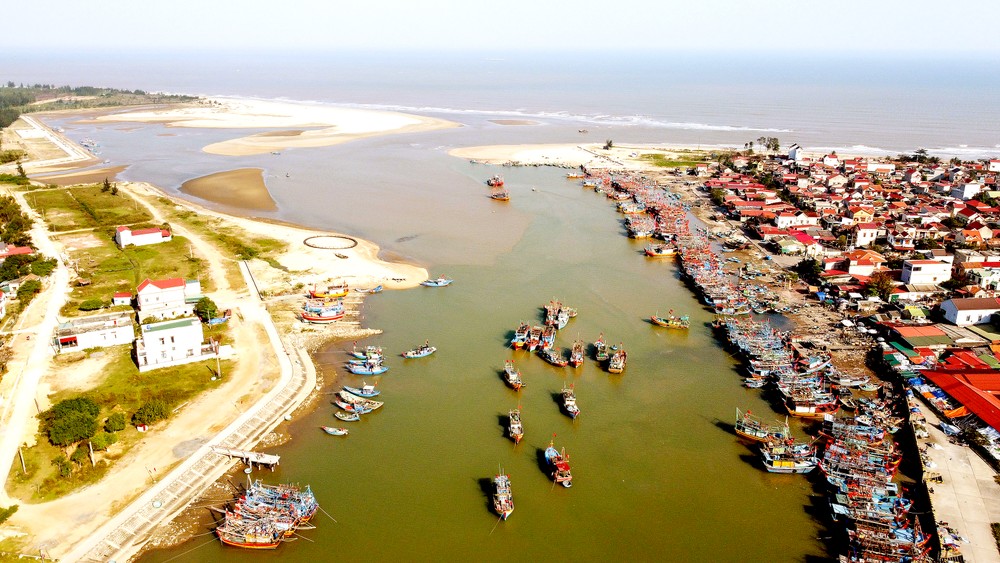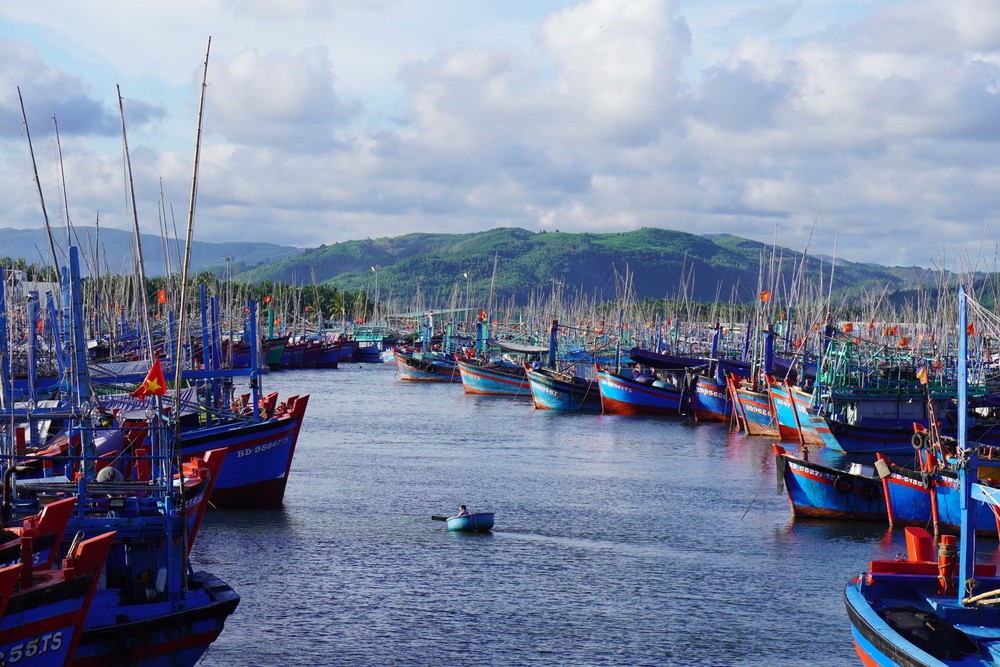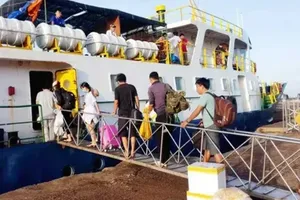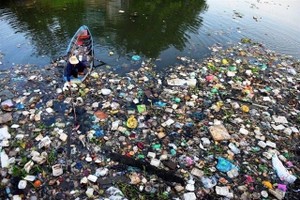
Furthermore, onshore logistical support services have not attained the desired level of efficacy. Concurrently, the aging fishing workforce and a shortage of young people entering the industry exacerbate the challenges faced by the sector. This real situation is pervasive along the central coast, further impeding fishing operations.
Severe silting is gradually narrowing the ports, fishing wharves, channels, and boat mooring areas in the central region's estuaries. This is causing congestion for fishing boats and significantly disrupting fishing operations, logistics services, and storm shelters. Although fishermen and localities have cried for help many times, this situation has not improved.
The Cua Khau sea channel, spanning several hectares, has experienced significant siltation. Currently, over 100 fishing vessels of various types, belonging to both local and external fishermen, are stranded and exposed, awaiting the tide to rise so they can venture out to sea.
Fisherman Dang Van Luan, aged 46 and residing in Tien Thang village, gazes forlornly at his boat, which has a nearly 90CV capacity, now grounded. He lamented that due to the channel's proximity to the river mouth, the issue of soil and sand accumulation has severely impacted the channel for nearly a decade.
During low tide, the majority of boats are unable to navigate in or out of the harbor. Upon returning from fishing expeditions, fishermen have no choice but to anchor 2-3 kilometers offshore from the channel and subsequently hire small boats to transport the seafood to the shore. Each of these trips incurs an extra cost ranging from VND200,000 to VND500,000. This situation not only elevates expenses but also results in time inefficiencies, creates a passive experience for the fishermen, and adversely impacts both the quality of the seafood and their overall income.
Fisherman Dang Van Luan was moaning that, unable to navigate the channel, boats are forced to anchor offshore, exposing them to significant risks. Recently, in June and July 2024, two fishing boats from the commune were sunk by waves, resulting in substantial property losses. Furthermore, numerous boats sustained damage after colliding with sand dunes, leading to additional repair expenses.
The Roon estuary, located between Quang Phu and Canh Duong communes in Quang Binh Province’s Quang Trach District, is also suffering from severe silting. From an aerial view, the estuary appears as an expansive stretch of mud and sand, completely obstructing the passage.
Fishermen reported that the local government once initiated a dredging project along the southern bank of Canh Duong commune. However, the effort was like a drop in the ocean and failed to clear the channel effectively.
In Quang Ngai and Binh Dinh provinces, many seaports and estuaries such as Cua Dai in Co Luy, My A, Sa Can of Quang Ngai Province or Tam Quan, An Du of Binh Dinh Province are also being silted up, causing many difficulties for fishermen.
70-year-old fisherman Nguyen Duy Tan said for over 15 years, though fishermen petitioned that the seaport should be dredged so that ships can enter and exit easily, the local government showed no interest in the issue.
Currently, fishermen feels no difference between the province with a seaport and other localities without one. The Hoai Huong fishing fleet, along with hundreds of other boats in the area, must travel 5-6 nautical miles to anchor at the Tam Quan estuary—a significant inconvenience, especially during the rainy and stormy season. To make matters worse, the Tam Quan estuary is already overcrowded and plagued by siltation.
At Tam Quan fishing port, a representative from the Tam Quan Fishing Port and Urban Services Management Board stated that, in terms of district and town-level scale, Tam Quan Port is the largest in the country. It accommodates an offshore fishing fleet comprising 2,114 boats over 15 meters in length and 480 boats under 15 meters.
Moreover, he revealed that this location serves as the foremost tuna export fishing hub in the nation, boasting a fleet of 1,500 tuna fishing vessels and producing nearly 10,000 tons annually. Despite its impressive scale, the current state of the Tam Quan estuary evokes a sense of sadness, as it has now become as constricted as a narrow stork’s neck. Numerous boats at the fishing port seeking to venture into the open sea require the assistance of a smaller vessel to tow and navigate them through the estuary.
Vice Chairman Phan Cong Thoan of the People's Committee in Ky Ninh Commune in Ha Tinh Province’s Ky Anh Town reported that the entire commune has over 250 boats of various types. Previously, the Cua Khau sea channel measured 2km wide at high tide, but it has since silted up to less than 1km in width. The channel's shallow depth forces fishermen’s boats to rely entirely on the tides for navigation, significantly disrupting production activities. Moreover, frequent incidents result in substantial damage.
Despite repeated petitions from local authorities and fishermen urging the provincial and central governments to dredge the channel, no action has been taken.
The Vice Chairman said that in 2017, there was a plan to construct a fishing port and dredge the channel between Cua Khau and Ky Ha commune, with a budget of nearly VND700 billion (US$27,570,016). However, this project has not been implemented to date.

According to him, small dredging projects will not be effective because after dredging, the following storms will cause sand and soil to continue to flow down, re-silting the channel. Therefore, the locality is waiting for large-scale projects to combine dredging with the synchronous construction of a sea dike system to prevent sand and soil from flowing down, then the sedimentation situation will be fundamentally resolved. However, the local authorities remain uncertain about when such a project might be implemented.
Director Tran Van Phuc of the Department of Agriculture and Rural Development of Binh Dinh Province said that An Du estuary used to be a place with a large number of ships and busy fishing activities before 2000. Nevertheless, the estuary has become completely silted up since then, leading to the closure of numerous local commercial and aquatic service establishments and the loss of many jobs in the community.
At the end of 2019, the People’s Committee of Binh Dinh Province has hired a consultation firm for evaluating the erosion and silting of the An Du estuary, aiming to have a comprehensive and long-term solution.
By 2021, the province's Department of Agriculture and Rural Development had reported to superiors on the current situation and assessed solutions to revive An Du estuary. Recently, on July 3, 2024, the Prime Minister issued Decision No. 582/QD-TTg approving the planning of the fishing port system and storm shelters for fishing vessels for the 2021-2030 period, with a vision to 2050, in which Hoai Huong fishing port is planned as a type III fishing port, combined with a storm shelter.
























